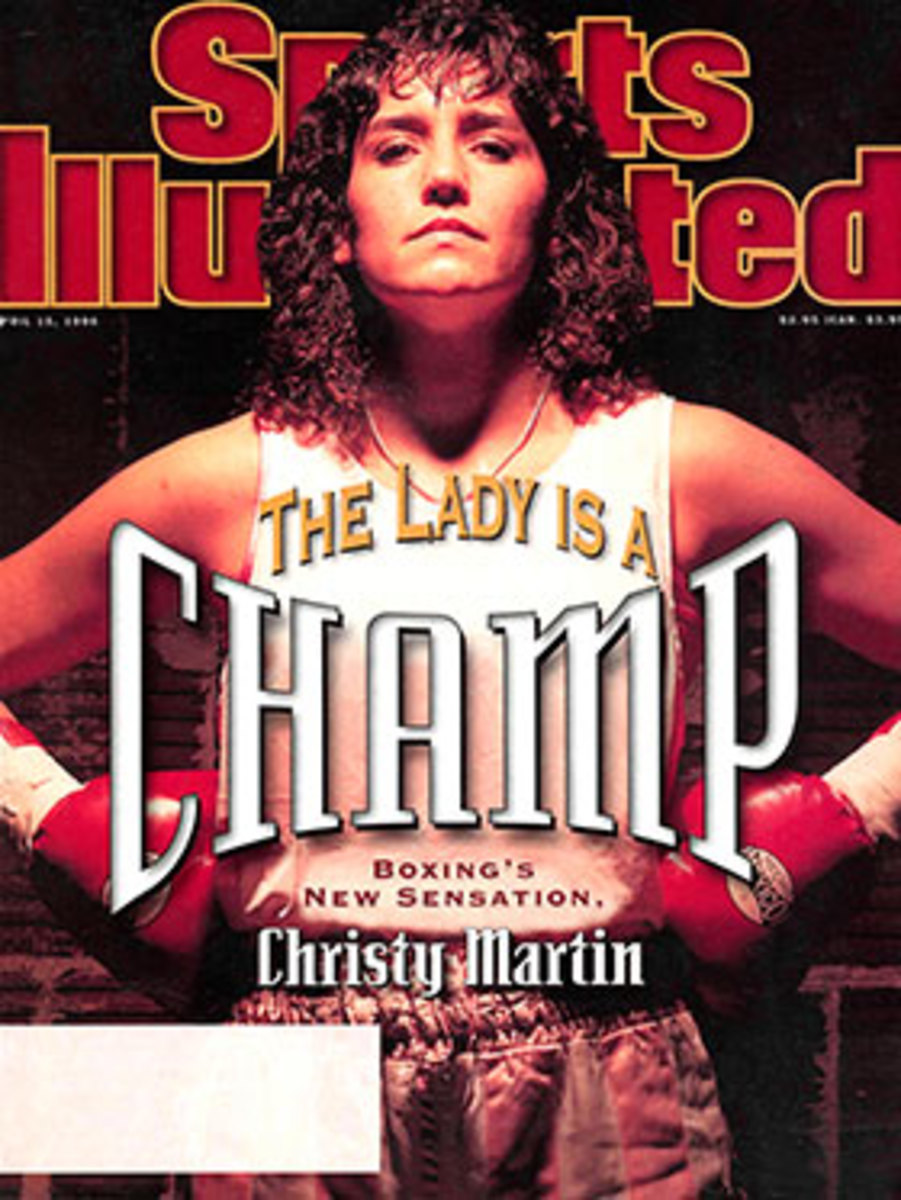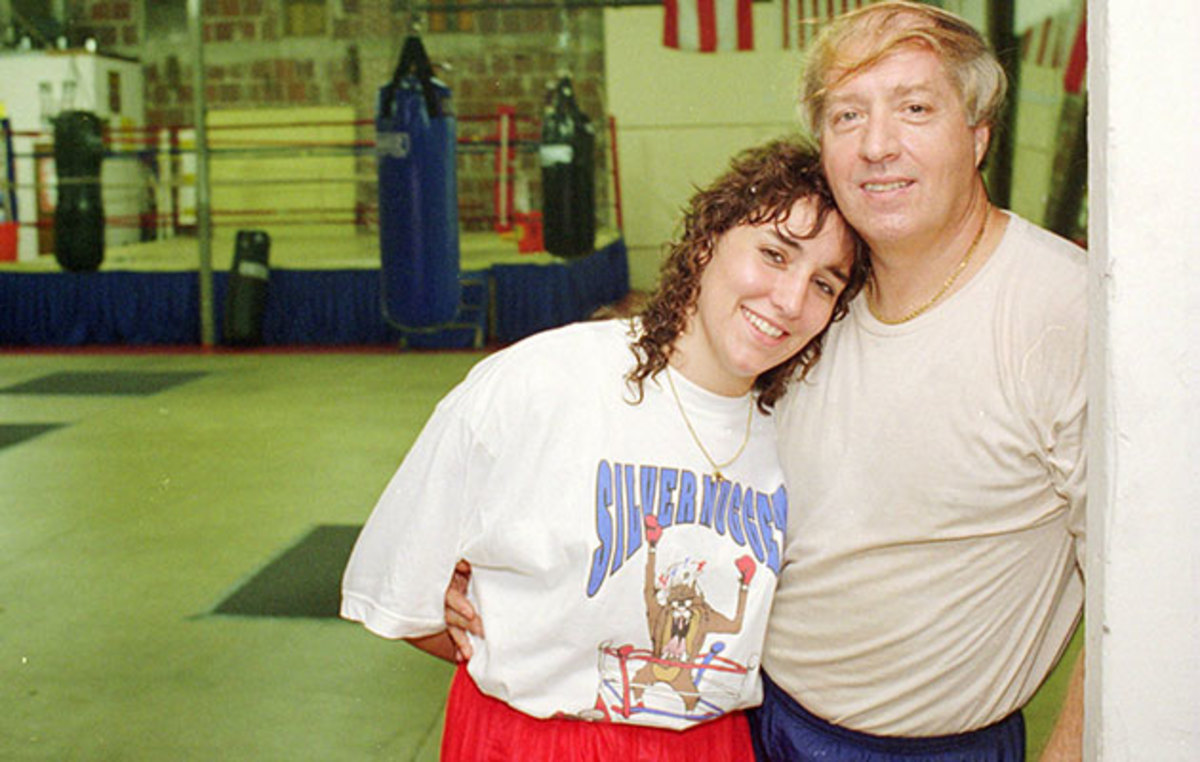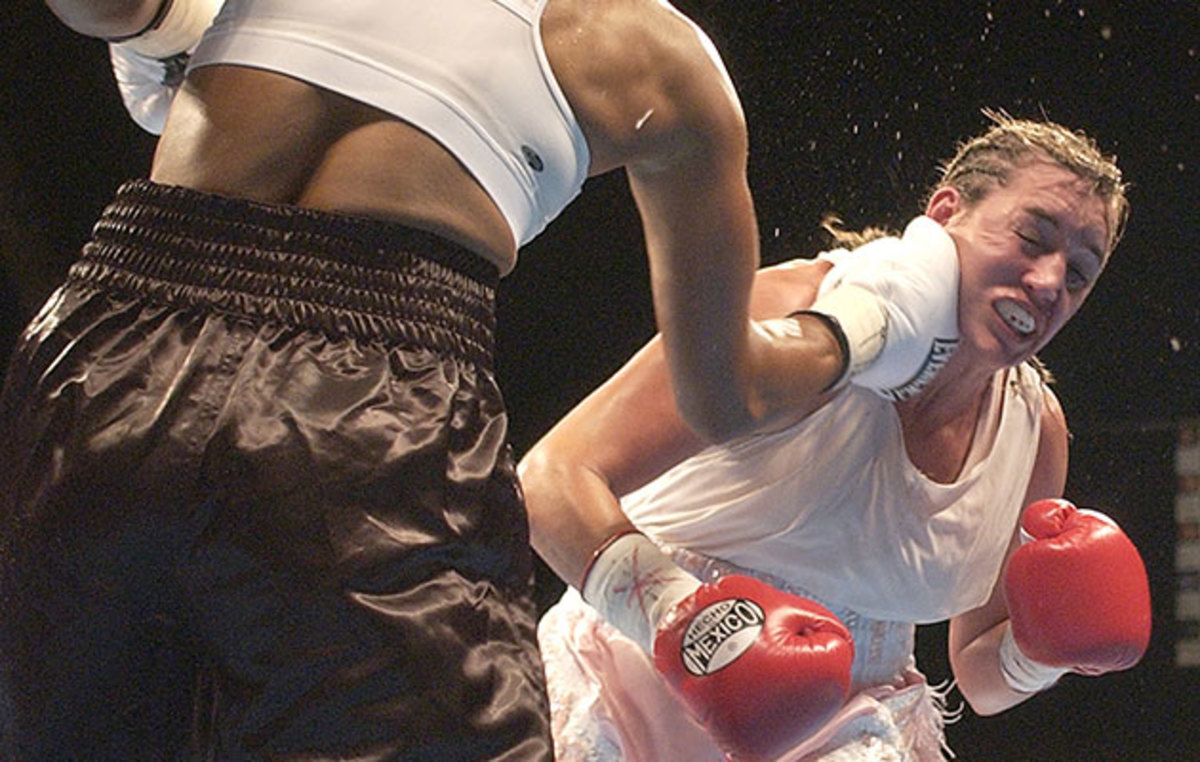Christy Martin fights for her new life six years after being left to die

The gun was pink. Christy Martin knew as much because the nine-millimeter that her husband, Jim, aimed at her chest six years ago was, in fact, her gun. And pink was her color.
Years before that, a small-time promoter had first dressed her in pink as a marketing ploy, and the color stuck as she climbed boxing’s ranks. She sported a pink robe, which she accented with a championship belt in 1996. She rocked pink wrist tape at crowded press events; she was one of Don King’s biggest draws when Mike Tyson was unavailable. And when Christy Martin ushered women’s boxing into the mainstream by appearing on the April 15, 1996 cover of Sports Illustrated, she did so wearing pink shorts. Pink got her recognized on Rodeo Drive and Fifth Avenue. But now the only pink she could see was the blurry barrel of a Glock, safety off, loaded with a metallic bullet.
Before taking aim that afternoon at their house outside Orlando, Jim Martin had repeatedly pistol-whipped his wife, bashed her head into a dresser and stabbed her three times in the chest. Blood gurgled from Christy’s collapsed left lung; her left calf was slashed nearly to the bone.
“You can’t f------ kill me,” she cried out.
And that’s when Jim shot her in the chest, leaving her to die.
Christy Martin goes by her maiden name now, Christy Salters, and on a cool April day she is again slipping her hands into gloves—first over her left, then her right. But these gloves are the clear, thin and plastic variety. She’s not fighting this morning. She’s gardening. And she’s joined by a dozen special education students at Vance High in Charlotte. She helps one girl with limited motor skills get her hands into the latex, then searches for a custodian who can turn on the water outside the cafeteria. The group is planting potatoes that have been growing roots inside their classroom.
Salters, 48, has been a full-time substitute at Vance for nearly two years, but only a handful of her coworkers know her story. There’s the history teacher who told Salters that as a kid she had a poster hanging on her bedroom wall of the triumphant women’s boxer. And there’s the theater instructor, a former Broadway actor with whom Salters bonded and talked about starting over.
Otherwise, Salters has not opened up much about her past. When she sees her students working at computers, she often thinks, Please don’t Google me. She knows the headlines would test the school’s safe-search filter.
This is what the kids would learn: Salters never set out to become a boxing pioneer. She grew up playing basketball in Itmann, W.Va., home to hardly 500 and the inspiration for her boxing nickname, the Coalminer’s Daughter. While she was at nearby Concord College, earning a degree in education on a scholarship as an undersized forward, she won $1,000 in a boxing competition. After graduation she put her teaching plans on hold for six months to give the ring life a try. She earned a draw in her first match and won by knockout against the same opponent a month later. In 1990, a promoter connected her with a proper trainer.

Watching Christy—all 5' 4 1⁄2", 140 pounds of her—walk into the Bristol, Tenn., gym where he’d trained countless small-time male fighters, Jim Martin grumbled with annoyance. He resolved to scare her off by having one of his guys break her ribs in a sparring session. Then he saw that she had real skill. And marketability. By 1992, Jim had convinced Christy (24 years his junior) to marry him.
Looking back, Salters says she married only to project a traditional image. She had been intimate with men and women in college, but she worried that her interest in women would kill her boxing career before it began and leave her conservative family ashamed. Plus, she says, Jim had warped her worldview. He convinced her that her family didn’t love her and that no other manager would consider working with her. The only person Christy could trust, Jim made her believe, was her new husband.
And for a while that arrangement worked. After the couple moved to Florida in 1991, Christy became the first woman to sign with Don King. In ’94, she made her Las Vegas debut, winning by first-round knockout. Her fame reached another level two years later when—with a gushing bloody nose that played well for the cameras—she defeated Deirdre Gogarty by unanimous decision to become the nominal women’s lightweight champion of the world. Then came the SI cover and the appearances on David Letterman’s show and on 60 Minutes. Her fight fee skyrocketed from $15,000 to $150,000 nearly overnight. King and Tyson presented Christy with a white BMW Z3 straight out of a James Bond movie. She treated herself to a Harley-Davidson—pink, of course.
“She was the girl who put women’s boxing on the map,” says trainer Miguel Diaz, who worked Christy’s corner in addition to serving Manny Pacquiao and Floyd Mayweather. As Christy rose to fame, the New York Golden Gloves notably added a women’s bracket to its competition, breaking seven decades of all-male tradition. Suddenly, gyms were offering coed boxing classes. The stage was set for Million Dollar Baby.
• From the Vault (1996): Christy Martin knocking down boxing stereotypes
Christy went two more years—nine in a row total—without a loss until December 1998, when Sumya Anani upset her by majority decision. In a tearful postfight interview the 30-year-old announced she’d had her fill. “I’m ready to move on with my life,” she said.
Not quite. Retiring, she came to realize, would mean forfeiting the benefits she’d realized in and out of the boxing ring. She’d also still be stuck with Jim, who she says was increasingly controlling and physically abusive. “I felt threatened from the day of the marriage,” she says. “I’d never been knocked out except by Jim.” Salters refers to Martin now as her “puppet master” during those years—he limited whom she could talk to and what she could say. (Jim did not respond to a request for comment from SI, but in 2011 he did tell E:60 that he did not shoot or stab his wife.)
Christy fought eight more times until her contract with King ended in 2001 and it became clear that she was past her prime. In ’03 she suffered her first defeat by knockout, to Laila Ali; two years later, she dropped a unanimous decision to an upstart named Holly Holm. By the end of ’06, Christy had five losses and none of the media shine. Out of the public eye, she felt overwhelmed. The beatings she had taken in the ring, her hidden sexuality, the abusive marriage—they all left her racked with depression. On multiple occasions, she says, she went so far as to put a pistol in her mouth.
She found an escape in cocaine, which she says Jim always supplied to her. By 2008 she was spending her days strung out, with no sleep, seeking a hit first thing in the morning. When she did train, Jim would help her snort a line so she didn’t have to take off her gloves. Often, she refused to go outside, even to the mailbox, for fear of someone seeing her pale skin and bloodshot eyes. She’d earned at least $4 million over her career, but that money had quickly disappeared.
For nearly two decades, Salters says now, Jim had threatened to kill her if she ever left. As he neared 70, she felt she had become pretty much his entire life—his companion and his source of income. He would occasionally hit her (body shots, to hide the damage), Salters recalls, and then he’d say, “I don’t have much longer to live anyway.” By 2010, she says she’d given up. “I felt my life was very close to the end.”
The breakthrough came online: Christy reconnected on Facebook with an old high school lover, Sherry Lusk, and found a glimpse of happiness. Encouraged by the new connection, she cut her cocaine addiction; she told Jim she’d had enough and contacted a divorce lawyer. Then, on Nov. 22, she drove her yellow Corvette to a Comfort Inn near the beach in Daytona Beach, where she met Lusk and stayed overnight. When the two woman kissed outside their room, Jim was watching.
As Christy returned home the following afternoon she could hear Jim sharpening a knife in the kitchen. She retreated to her bedroom with a splitting headache and had one shoe off when Jim entered, holding a buck knife behind his back. After Jim stabbed his wife three times in the chest and slashed her leg, beat her to the brink of unconsciousness and shot her with her 9mm, he went to the bathroom to wash off. Lying on the floor at the foot of her bed, Christy stared up at a ceiling vent and prayed, “God, just please don’t let me die.”
A year later, during the trial for Jim (who is serving the minimum 25-year sentence at Graceville [Fla.] Correctional Facility for second-degree attempted murder and aggravated battery with a deadly weapon), Christy struggled to explain what happened next. While Jim showered off, she later testified, she somehow stumbled out the front door and hailed a passing driver, who took her to the emergency room. “To this day,” says the survivor of a gunshot that lodged four inches from her heart, “I think God carried me out of there.”

One of Christy’s first calls from Orlando Regional Medical Center was to Diaz, the Las Vegas–based trainer who she knew had ties to promoter Bob Arum. She wanted to reboot her fighting career using her maiden name, and she wanted Diaz to replace Jim in her corner. “Boxing was the best therapy I could find,” says Salters, who spent seven days hospitalized and returned to the gym on the eighth. “That’s where I felt the safest.”
One hundred ninety-three days after she was stabbed and shot, even after a training accident in which a sparring partner broke a rib that had been damaged by Jim’s bullet, Christy reentered the ring, again in pink shorts; at age 43 she was hunting career victory number 50 against Dakota Stone. Christy showed flashes of her old hitting prowess, but in the sixth and final round a doctor halted the match, suspecting that she had broken her right hand. She begged him to let her suffer through the final 51 seconds—“Please, please, no,”—but he ended the fight. Afterward, X-rays showed nine fractures. A two-hour operation turned into six hours, and when the anesthesia wore off Christy could not talk. She had suffered a stroke that racked the right side of her body.
For days she could barely walk. Her eyes were crossed. She struggled to lift a fork. Still, she kept the setback a secret. She knew she wouldn’t be allowed in any ring—she wouldn’t win that 50th bout—if her condition was made public. Then, on Aug. 14, 2012, in Friant, Calif., she fought Mia St. John, whom she’d beaten by unanimous decision a decade earlier. This time St. John won by decision in 10 rounds.
That Salters even stepped into the ring that evening remains one of her biggest regrets, and she is continuously coping with the ramifications, including double vision and lack of stamina. After that, her final loss in her final bout, she could not bring herself to train for another fight again. She ended her career with a record of 49-7-3. After two decades chasing a dream that turned into a nightmare, she says, “I’ve finally entered the real world.”

Even after moving to Charlotte to start over, Salters hasn’t entirely left boxing behind. She’s a frequent visitor at Ultimate Gym, run by Doug Brafford, who at first failed to recognize his new member but then noted immediately that she moved with the grace of a pro fighter. Eventually Christy opened up about her boxing career, about the attack on her life, and when she slipped into Brafford’s full-size ring, directly under a skylight, he would catch himself staring slack-jawed at this tough woman, the one who used to drop her hands and implore opponents, “Come on, do something!”
But those opportunities are rare, and when Christy pays Brafford a visit at his gym one afternoon in April, they share the embrace of two people who have a lot of catching up to do. “It’s been too long,” Salters tells him. “I can’t take it anymore. I need to sweat.”
Not that she has the time. Salters often works 14-hour days, split between Vance and a second job where she helps veterans and disabled adults find steady employment. On the rare occasion she does find an opening in her schedule, Salters draws on her past misfortunes to help others. In 2013, she visited Capitol Hill and told her story to senators in support of the Protecting Domestic Violence and Stalking Victims Act. “If that’s why I had to go through what I did, to help save other people,” she says, “that’s O.K. with me. I made it, and so many people do not.” When she learned that one of those speeches compelled a listener to get help for a loved one in an abusive situation, she felt encouraged.
• SI’s Where Are They Now issue: This year’s stories, all in one place
Salters is happier today than she once was, and working with students who struggle to read and write helps put her own situation in perspective. But Salters is clear on this: She has found no salvation. She lives alone. She is trying to make things work with Lusk, but trusting people is not easy. She’s still adjusting to a more sedentary life, which leaves her with more time to dwell on her past. She’s not sure where to go from here. “I still think happiness is out there,” she says. “Something’s going to happen and I’m going to be like, Wow, and that will start the new path in my life.”
In the meantime, she retains a soft spot for the fight game. At Ultimate, Brafford tells her someone is trying to organize a card, which is notable in Charlotte, still something of a boxing backwater. Salters herself is hoping to organize an event under her Pink Promotions banner. When the conversation turns to a particularly mouthy upstart, Salters blurts out, “I want to beat her ass!”
Such is the plight of the former champ—the one who just keeps saying, I can go one more round. Salters still weighs herself every morning; she texts Diaz to tell him she’s close to her fighting weight, just south of 150 pounds. No, he’ll respond. You’re done. Other times, Salters can see it clearly herself. “I’m old,” she tells herself. “I have to face the facts.”
Another harsh reality: Eventually her coworkers and her students will know the story of Christy Martin. Some will get hung up on the salacious details; others will find a new respect for the quiet substitute teacher. But Salters is ready for that. She’s ready for everyone around her to learn who she has become.
Christy Martin was a star. Christy Salters is a fighter.
